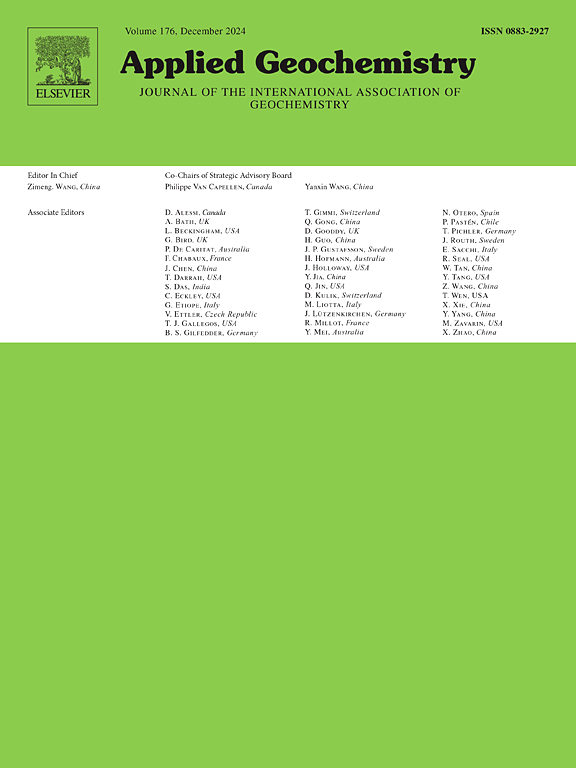Structural characterization of amorphous hydrous Zr(IV) oxide and the transformation occurring under hydrothermal conditions
IF 3.1
3区 地球科学
Q1 GEOCHEMISTRY & GEOPHYSICS
引用次数: 0
Abstract
The impact of temperature on the transformation of ZrO2(am, hyd) in aqueous systems was systematically investigated using a multi-method approach for solid phase characterization. Ageing at T = 80 °C in NaOH and alkaline CaCl2–Ca(OH)2 solutions triggered the conversion of ZrO2(am, hyd) to more crystalline, thermodynamically stable anhydrous oxides. Compared to the fresh amorphous solid and solids aged at T = 22 °C, an increase in crystallinity and particle size accompanied by a significant decrease in the amount of hydration water or hydroxide was observed. After equilibration for 4 or 10 months at T = 80 °C, XRD measurements confirmed the predominance of monoclinic ZrO2 with a particle size of 23–27 nm in NaOH systems, whereas tetragonal/cubic ZrO2 with a particle size of 11–14 nm formed in CaCl2–Ca(OH)2 solutions. All solids aged at T = 22 °C remained X-ray amorphous within the timeframe of this study. Rietveld refinement of the XRD patterns, EDX and EXAFS supported that the stabilization of a different crystal structure in CaCl2–Ca(OH)2 systems is caused by the incorporation of Ca2+ in the ZrO2 structure. The weight loss observed with TG-DTA was attributed to a decreasing amount of hydration water during the ageing at T = 80 °C. Assuming a stoichiometry of ZrO2·nH2O, the fresh solid showed a weight loss corresponding to n = 2.1, which remained constant during the ageing at T = 22 °C. The solids aged at T = 80 °C showed a smaller weight loss corresponding to n = 0.2–0.6. This behavior was qualitatively confirmed by IR-ATR. XPS analysis of the O1s line also showed a decrease of H2O/OH− contributions and an increase of O2− contributions in the solid phases aged at T = 80 °C.
This study provides new insights for the understanding of the transformation of M(IV) amorphous, hydrous oxides into the thermodynamically stable anhydrous crystalline oxide phases. The process involves particle growth, increased ordering and loss of H2O/OH− groups. In aqueous systems, the presence of other metal ions like Ca2+ may promote the stabilization of different crystal structures, even if they are found at low concentrations.
无定形水合氧化锆的结构表征及水热条件下的相变
采用多种固相表征方法,系统研究了温度对ZrO2(am, hyd)在水溶液中转变的影响。在T = 80°C的NaOH和碱性CaCl2-Ca (OH)2溶液中老化,引发ZrO2(am, hyd)转化为更结晶的、热力学稳定的无水氧化物。与新鲜的无定形固体和在T = 22℃时效的固体相比,结晶度和粒径增加,同时水化水或氢氧化物的量显著减少。在温度为80℃的条件下平衡4个月或10个月后,XRD测定结果证实,在NaOH体系中形成的ZrO2为单斜晶,粒径为23-27 nm,而在CaCl2-Ca (OH)2溶液中形成的ZrO2为四方/立方晶,粒径为11-14 nm。在本研究的时间框架内,所有在T = 22℃时效的固体均保持x射线无定形。XRD、EDX和EXAFS的Rietveld细化表明,Ca2+在ZrO2结构中的掺入导致了CaCl2-Ca (OH)2体系中不同晶体结构的稳定。TG-DTA观察到的重量下降是由于在T = 80°C老化过程中水化水量的减少。假设化学计量量为ZrO2·nH2O,新鲜固体的失重量为n = 2.1,在T = 22℃老化过程中保持不变。当n = 0.2 ~ 0.6时,T = 80℃时效的固体失重较小。IR-ATR定性证实了这一行为。O1s线的XPS分析也表明,在T = 80℃时效固相中,H2O/OH -的贡献减少,O2 -的贡献增加。该研究为理解M(IV)无定形水合氧化物向热力学稳定的无水氧化结晶相转变提供了新的见解。这一过程包括粒子生长、有序度增加和H2O/OH−基团的损失。在水体系中,其他金属离子如Ca2+的存在可能会促进不同晶体结构的稳定,即使它们的浓度很低。
本文章由计算机程序翻译,如有差异,请以英文原文为准。
求助全文
约1分钟内获得全文
求助全文
来源期刊

Applied Geochemistry
地学-地球化学与地球物理
CiteScore
6.10
自引率
8.80%
发文量
272
审稿时长
65 days
期刊介绍:
Applied Geochemistry is an international journal devoted to publication of original research papers, rapid research communications and selected review papers in geochemistry and urban geochemistry which have some practical application to an aspect of human endeavour, such as the preservation of the environment, health, waste disposal and the search for resources. Papers on applications of inorganic, organic and isotope geochemistry and geochemical processes are therefore welcome provided they meet the main criterion. Spatial and temporal monitoring case studies are only of interest to our international readership if they present new ideas of broad application.
Topics covered include: (1) Environmental geochemistry (including natural and anthropogenic aspects, and protection and remediation strategies); (2) Hydrogeochemistry (surface and groundwater); (3) Medical (urban) geochemistry; (4) The search for energy resources (in particular unconventional oil and gas or emerging metal resources); (5) Energy exploitation (in particular geothermal energy and CCS); (6) Upgrading of energy and mineral resources where there is a direct geochemical application; and (7) Waste disposal, including nuclear waste disposal.
 求助内容:
求助内容: 应助结果提醒方式:
应助结果提醒方式:


